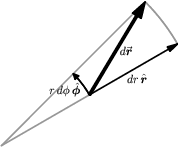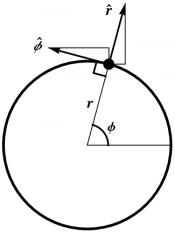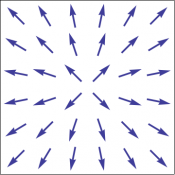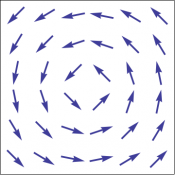You are here: start » book » guidecontent » coordinates
It is important to realize that $d\rr$ and $ds$ are defined geometrically, not by ($\ref{drdef}$) and ($\ref{dsdef}$). To emphasize this coordinate-independent nature of $d\rr$, it is useful to study $d\rr$ in another coordinate system, such as polar coordinates ($r$,$\phi$) in the plane. 1) It is also natural to introduce basis vectors $\{\rhat,\phat\}$ adapted to these coordinates, with $\rhat$ being the unit vector in the radial direction, and $\phat$ being the unit vector in the direction of increasing $\phi$. One can of course relate $\rhat$ and $\phat$ to $\ii$ and $\jj$, for instance using the first drawing in Figure 3.3. However, in most physical applications (as opposed to problems in calculus textbooks) this can be avoided by making an appropriate initial choice of coordinates.
Determining the lengths of the sides of the resulting infinitesimal polar “rectangle”, one obtains \begin{equation} d\rr = dr\,\rhat + r\,d\phi\,\phat \label{dr2} \end{equation} as shown in Figure 3.2c. Using ($\ref{dsdef}$) and squaring both sides as before leads to \begin{equation} ds^2 = dr^2 + r^2 \, d\phi^2 \label{ds2} \end{equation} which is the infinitesimal Pythagorean Theorem in polar coordinates
Analogous expressions can be derived for $d\rr$ in other coordinate systems, some of which we will use below. A worksheet which we often assign for homework is attached at the end of this chapter.
When using basis vectors adapted to curvilinear coordinates, it is essential to realize that the basis vectors are not constant. The polar basis $\{\rhat,\phat\}$ is shown in Figure 3.3.
Figure 3.3: The polar basis $\rhat,\phat$ is constructed at any point in the plane as shown in the first drawing. The last two drawings show the resulting vector fields $\rhat$ and $\phat$, respectively.


